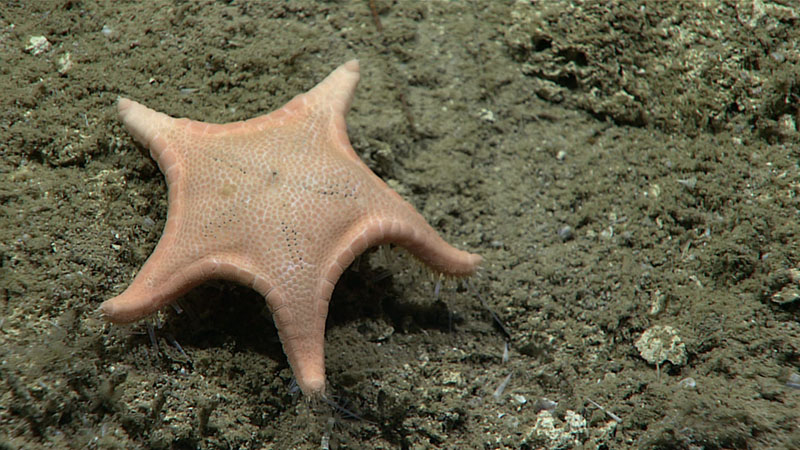https://oceanexplorer.noaa.gov/news/oer-updates/2020/sea-stars.html?utm_medium=email&utm_source=govdelivery
April 22, 2020
Sea stars play an important role in deep-sea ecosystems, especially as predators of sponges and corals (mostly octocorals). This was the key finding of a new article by Christopher L. Mah in the scientific journal Zootaxa that summarizes feeding observations of 28 species of sea stars from seven expeditions on NOAA Ship Okeanos Explorer in the Atlantic Ocean between 2017 and 2019. Almost all of these observations were first-time in situ feeding observations (e.g., Cladaster rudis, Floriaster maya, Gilbertaster caribaea, Sthenaster emmae, Pythonaster atlantidis), and almost all of them mark the first time these species were seen alive.
This sea star (Floriaster maya) was seen alive (and feeding) for the first time near Florida’s Dry Tortugas in the Gulf of Mexico during the 2019 Southeastern U.S. Deep-sea Exploration. Image courtesy of the NOAA Office of Ocean Exploration and Research, 2019 Southeastern U.S. Deep-sea Exploration. Download larger version (1 MB).
The Name Game
Based on specimens and observations collected during these expeditions, Mah described two new sea star species and named them after important contributors to deep-sea research:
Evoplosoma nizinskiae was named for Dr. Martha Nizinski, a researcher from NOAA’s National Marine Fisheries Service who has worked tirelessly on deep-sea coral ecology.
This sea star (Evoplosoma nizinskiae) was seen feeding on a bamboo coral in the Virgin Islands Trough during the Océano Profundo 2018: Exploring Deep-sea Habitats off Puerto Rico and the U.S. Virgin Islands expedition. Image courtesy of the NOAA Office of Ocean Exploration and Research, Exploring Deep-sea Habitats off Puerto Rico and the U.S. Virgin Islands. Download larger version (927 KB).
Sibogaster bathyheuretor was named for the NOAA Office of Ocean Exploration and Research’s remotely operated vehicle Deep Discoverer, which was used to image and collect the subjects of this study. The Latin name “bathyheuretor,” derived from Greek, translates to “deep discoverer.”
Named after OER’s remotely operated vehicle Deep Discoverer, this sea star (Sibogaster bathyheuretor) was seen feeding on food items from the soft, unconsolidated seafloor during the Gulf of Mexico 2018 expedition. Image courtesy of the NOAA Office of Ocean Exploration and Research, Gulf of Mexico 2018. Download larger version (1.2 MB).
What’s for Dinner?
This sea star (Pythonaster atlantidis), from a poorly understood and rarely seen genus of sea stars, was observed feeding on a glass sponge during the Gulf of Mexico 2018 expedition. Image courtesy of the NOAA Office of Ocean Exploration and Research, Gulf of Mexico 2018. Download larger version (1.2 MB).
Feeding observations in the deep-sea are uncommon, but they can tell us a lot about the predators, their prey, and their surrounding environments. The observations featured in the journal article include 10 sea star species feeding on various corals, including octocorals, black corals, and stony coral; eight feeding on deep-sea sponges, both glass and demosponges; and four feeding in the sediment.
Also included are two extraordinary observations of multiple “cookie stars” (Peltaster placenta and Plinthaster dentatus) and a sea urchin (Cidaris rugosa) feeding on a large barrel sponge (Geodia). These observations suggest complex interactions among these deep-sea sea stars, which seemed to be pushing each other away to assert dominance over the large prey item. In both cases, the largest sea stars were on a high point on their respective sponge while the smaller sea stars appeared to have been pushed away. This behavior has also been observed in Antarctic shallow-water sea star species that feed on sponges.
Eight “cookie stars” (Peltaster placenta and Plinthaster dentatus) and a sea urchin (Cidaris rugosa) were seen feeding on a large barrel sponge (Geodia) off the coast of South Carolina during the Windows to the Deep 2019 expedition. Image courtesy of the NOAA Office of Ocean Exploration and Research, Windows to the Deep 2019. Download larger version (1.3 MB).
Access the article online (subscription/fee access)
Mah, C.L. (2020). New species, occurrence records and observations of predation by deep-sea Asteroidea (Echinodermata) from the North Atlantic by NOAA ship Okeanos Explorer. Zootaxa 4766 (2): 201–260. http://dx.doi.org/10.11646/zootaxa.4766.2.1h







